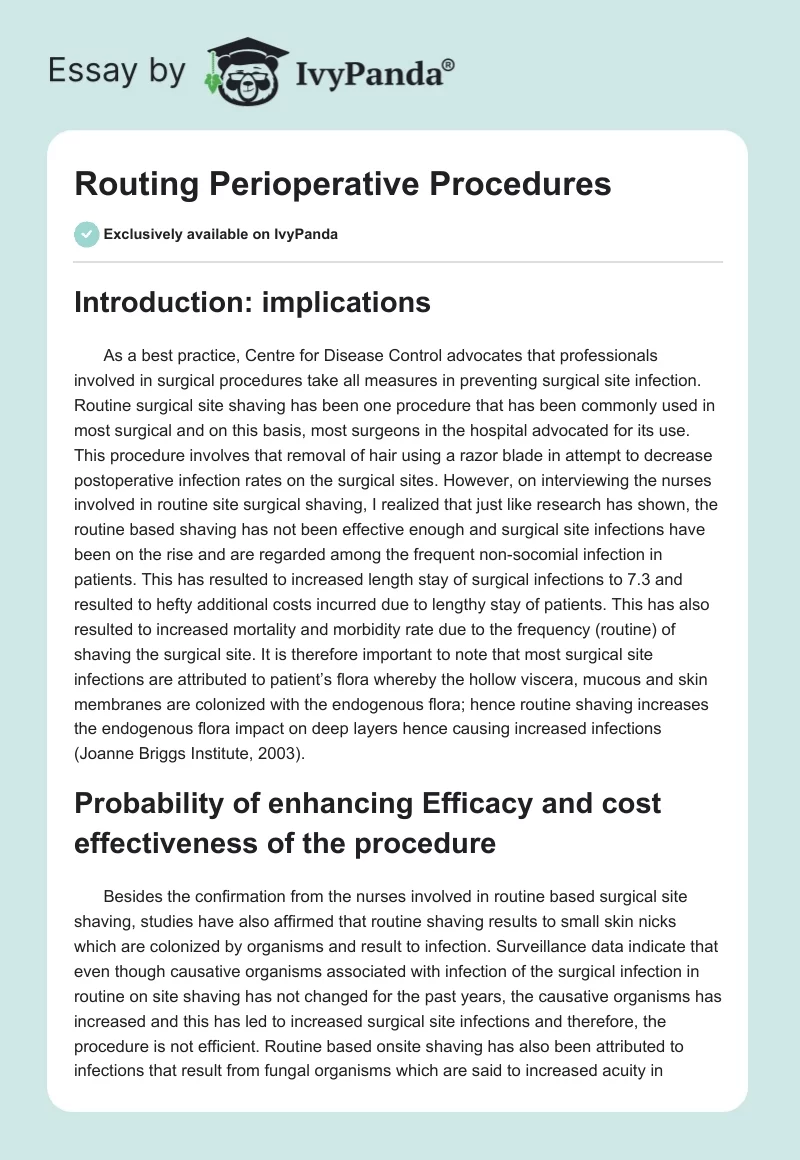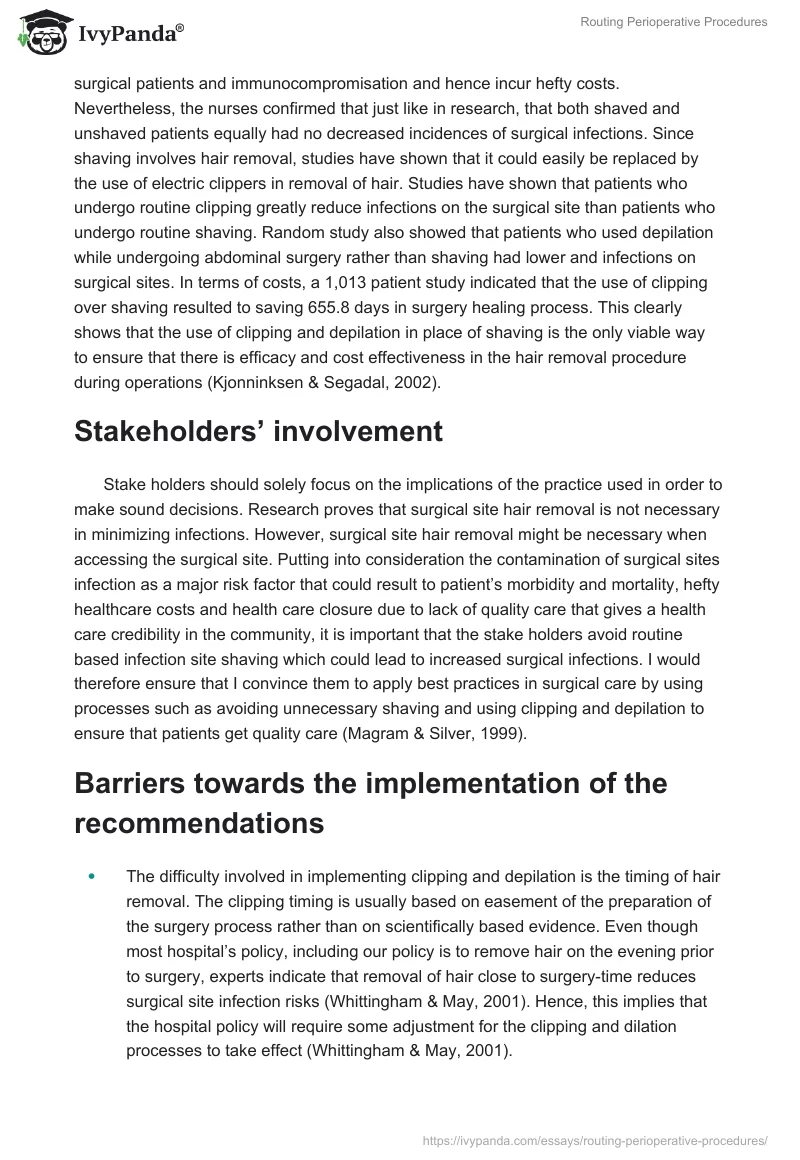Introduction: implications
As a best practice, Centre for Disease Control advocates that professionals involved in surgical procedures take all measures in preventing surgical site infection. Routine surgical site shaving has been one procedure that has been commonly used in most surgical and on this basis, most surgeons in the hospital advocated for its use. This procedure involves that removal of hair using a razor blade in attempt to decrease postoperative infection rates on the surgical sites. However, on interviewing the nurses involved in routine site surgical shaving, I realized that just like research has shown, the routine based shaving has not been effective enough and surgical site infections have been on the rise and are regarded among the frequent non-socomial infection in patients. This has resulted to increased length stay of surgical infections to 7.3 and resulted to hefty additional costs incurred due to lengthy stay of patients. This has also resulted to increased mortality and morbidity rate due to the frequency (routine) of shaving the surgical site. It is therefore important to note that most surgical site infections are attributed to patient’s flora whereby the hollow viscera, mucous and skin membranes are colonized with the endogenous flora; hence routine shaving increases the endogenous flora impact on deep layers hence causing increased infections (Joanne Briggs Institute, 2003).
Probability of enhancing Efficacy and cost effectiveness of the procedure
Besides the confirmation from the nurses involved in routine based surgical site shaving, studies have also affirmed that routine shaving results to small skin nicks which are colonized by organisms and result to infection. Surveillance data indicate that even though causative organisms associated with infection of the surgical infection in routine on site shaving has not changed for the past years, the causative organisms has increased and this has led to increased surgical site infections and therefore, the procedure is not efficient. Routine based onsite shaving has also been attributed to infections that result from fungal organisms which are said to increased acuity in surgical patients and immunocompromisation and hence incur hefty costs. Nevertheless, the nurses confirmed that just like in research, that both shaved and unshaved patients equally had no decreased incidences of surgical infections. Since shaving involves hair removal, studies have shown that it could easily be replaced by the use of electric clippers in removal of hair. Studies have shown that patients who undergo routine clipping greatly reduce infections on the surgical site than patients who undergo routine shaving. Random study also showed that patients who used depilation while undergoing abdominal surgery rather than shaving had lower and infections on surgical sites. In terms of costs, a 1,013 patient study indicated that the use of clipping over shaving resulted to saving 655.8 days in surgery healing process. This clearly shows that the use of clipping and depilation in place of shaving is the only viable way to ensure that there is efficacy and cost effectiveness in the hair removal procedure during operations (Kjonninksen & Segadal, 2002).
Stakeholders’ involvement
Stake holders should solely focus on the implications of the practice used in order to make sound decisions. Research proves that surgical site hair removal is not necessary in minimizing infections. However, surgical site hair removal might be necessary when accessing the surgical site. Putting into consideration the contamination of surgical sites infection as a major risk factor that could result to patient’s morbidity and mortality, hefty healthcare costs and health care closure due to lack of quality care that gives a health care credibility in the community, it is important that the stake holders avoid routine based infection site shaving which could lead to increased surgical infections. I would therefore ensure that I convince them to apply best practices in surgical care by using processes such as avoiding unnecessary shaving and using clipping and depilation to ensure that patients get quality care (Magram & Silver, 1999).
Barriers towards the implementation of the recommendations
- The difficulty involved in implementing clipping and depilation is the timing of hair removal. The clipping timing is usually based on easement of the preparation of the surgery process rather than on scientifically based evidence. Even though most hospital’s policy, including our policy is to remove hair on the evening prior to surgery, experts indicate that removal of hair close to surgery-time reduces surgical site infection risks (Whittingham & May, 2001). Hence, this implies that the hospital policy will require some adjustment for the clipping and dilation processes to take effect (Whittingham & May, 2001).
- There are several surgical wounds classification that are used to determine the risk category of surgical site towards infection (Whittingham & May, 2001). This is done on the basis of wound contamination degree at the time when the surgical process in done (Whittingham & May, 2001). The degree to which the round is contaminated is dependent on factors such as complexity of the surgical process and surgical candidate risk profile. Also, the previous research done by different individual clearly show that removing ones hair is a great risk factor. Since there is no set contamination degree for removal of hair, it is difficult to determine where clipping should or should not be used in terms of surgical wounds classification (Downs & Black, 2001).
- Studies also show that the depilatory creams usually have allergies and skin irritations and is therefore difficult to determine who is easily irritated or allergic to the creams as there are no appropriate test procedures that have been sent and scientifically approved.
Solutions
- The stakeholders including the hospital should come up with a policy that accommodates the correct clipping timing to ensure that the clipping process is carried out successfully.
- Owing that depilatory creams causes allergy and skin irritations, its best to stop using them until proper procedures for determining persons allergic to the creams are scientifically proved or until non-allergic depilatory creams are developed and medically approved.
- The nurses involve in performing the procedure should also be put under intensive training to ensure that they only perform the procedure when deemed necessary and under best practices.
Conclusion: implementation process efficacy
Also, as a nurse with a leadership role in surgical floor, I will ensure that the implementation process is carried out successfully by ensuring that the nurses involved in the clipping process perform the procedure in the right environment and using the correct timing in order to ensure that the procedure is successfully carried out. I will also make sure that I evaluate patient care and staff performance in the clipping procedure. I will also make sure that I report to the medical unit supervisor on the progress regarding the procedure, manage and train the staff about the procedure and how to handle clients and manage emergent and life threatening situations that quickly require the procedure (Magram & Silver, 1999).
References
Downs, SH. & Black N. (2001). ‘The feasibility of creating a checklist for the assessment of the methodological quality both of randomised and non-randomised studies of health care interventions’. Epidemiology Community Health Vol. 52, 377–84.
Joanne Briggs Institute. (2003). ‘The Impact of preoperative hair removal on surgical site infection’. Best practices. Vol. 7 (2). Pg.145-167.
Kjonninksen, A & Segadal, S. (2002). ‘Preoperative hair removal- a systematic literature review’. AORN. Vol. 75 (5), pg 928-940.
Magram. H. & Silver, P. (1999). ‘The hospital infection control practices advisory committee, guideline for prevention of surgical site infection’. Infection control and hospital epidemiology. Vol. 20, 247-280.
Whittingham, K. & May, S. (2001). Cleansing regimens for continence care. Prof Nurse. Vol. 14, 167–72.


